Antiques in Manchester
September 23rd, 2012
Taken from the bleacher seats in the JFK Coliseum, about an hour after the 3 p.m. opening on Wednesday, this photo shows that the joint is still jumping. The last time the coliseum was used for an antiques show, it had way too few exhibitors among huge areas of curtained-off bare floor. One had to feel sorry for the few who did set up then, and the overall impression was somber and lifeless. Some change!
Here's something you don't see at every show, a table/candlestand made entirely from the burl of an ash tree. Axtell Antiques, Deposit, New York, asked $25,000 for the 25" high piece with an 18½" wide top. The 1850-60 table is from New York or Ohio and appears on page 88 of North American Burl Treen: Colonial & Native American (2005) by Steven S. Powers. (It also appeared on page 15-A of this magazine way back in May 1978 in Sam Pennington's coverage of the Augusta Armory Show.)
Kelly Kinzle of New Oxford, Pennsylvania, brought some very rare and exciting stoneware to Manchester. The 1820's-30's "Tyler & Dillon/ Albany" water cooler with bird and floral decoration was $65,000, and the Ohio crock with clasped hands and the names "E. Hall/ Delilah Jane Stine" was $85,000. |
Manchester, New Hampshire
by David Hewett
It was easy to see why some said they suffered a mild case of sticker shock while walking the floors of the JFK Coliseum in Manchester, New Hampshire, on opening day of the newest show in town, DiSaia Management's Antiques in Manchester: The Collector's Fair, held August 8 and 9. Some visitors were unprepared for the sight of weathervanes bearing prices of $38,000, and $59,000, and $130,000, and (gulp!) $324,000; or $68,000 cupboards; or $58,000 highboys; or stoneware priced in the $65,000 to $85,000 range.
The opening gate was mobbed on Wednesday when Ralph DiSaia let the assembled multitudes loose at exactly 3 p.m. to storm the booths inside the coliseum.
Karen DiSaia had netted 46 exhibitors for the new show, many of them former exhibitors at one of Frank Gaglio's Barn Star Productions shows (25 exhibitors at Antiques in Manchester had been with Barn Star last year as exhibitors at Mid-Week or the Pickers Market).
For many of those who switched, it was not a reflection on Frank Gaglio's qualities as a show manager but was more a reaction to the circumstances of this year's events. Gaglio lost exhibition space in Manchester when the sites of his previous shows were sold or otherwise became unavailable, and he was forced to move both of his shows to Concord this year.
One of those former exhibitors said he switched because he did not want to do the Pickers show on Friday, toward the tail end of all the events and on the day when many people were heading home, and especially not in Concord, away from the traditional Manchester area. Others mentioned uncertainty around the move to Concord and their loyalty to the DiSaias as reasons for doing Antiques in Manchester.
Some visitors said they'd hit the other shows prior to coming to the coliseum and that it was refreshing to see so many quality antiques on display. Others reported that they couldn't get past the fact that prices were "out of sight," said usually with an exclamation mark after "sight."
The catch phrase for the show, The Collector's Fair, was used for a good reason. Exhibitors displayed some of their finest and rarest antiques and collectibles. There were superb stepback cupboards, very early 18th-century tavern tables, pieces of stoneware, delicate fabrics, and examples of metalwork.
A lot of merchandise sold in a very short time on Wednesday, despite those few who reported an initial case of sticker shock.
Norman and Mary Gronning sold a flat-top highboy; Mark and Marjorie Allen sold a round-top hutch table; and Brian Cullity sold a collection of stoneware heads that took him 30 years to put together. Samuel Herrup sold a fish weathervane that bore a $38,000 price tag when we first saw it.
HL Chalfant sold a Federal lyre-form banjo clock; John Keith Russell sold an 18th-century New England primitive candlestand; David Good and Samuel Forsythe sold a stoneware face jug; and James Kilvington sold a blanket chest and a ship model.
The list of exhibitors certainly was well sprinkled with the heavyweights in this business. Besides those mentioned above, there were Gemini Antiques, Fred Giampietro, Stephen and Carol Huber, Steven S. Powers, Raccoon Creek Antiques, Kelly Kinzle, Stella Rubin, Grace and Elliott Snyder, Heller Washam Antiques, Greg Kramer, The Cooley Gallery, and other well-known dealers who chose to do this event.
We spoke with Karen DiSaia several days after the show. "I thought it went very well for the first year," she said, from somewhere on the road ("But I'm not driving!"). "Everyone I spoke with was impressed with the size of the gate we pulled. In fact, the only complaint I heard was that too many people showed up. Oh, also that they wished we could have opened earlier than three p.m.
"We may change some things about the show, but we are very dealer-driven. We don't make changes without consulting everyone concerned. We went after additional exhibitors this year from the ranks of those who don't often do shows, and it was successful."
Asked about results, she paused and replied, "Gosh, there were so many people who told us they had had great shows. Take David Good and Sam Forsythe; they said they'd had the best show of any they'd ever had in New Hampshire. I know the Norwoods did well; so did Elle Shushan, and Colette Donovan. Every time I went by Colette's booth, she was making another sale.
"And lots of people came back to us after they'd done the [NHADA] show. Some said it was so crowded, they'd decided to come here and wait until the crowds had thinned out over there to go back."
Karen DiSaia said the setup had proved remarkably easy too. "On Wednesday exhibitors started unloading at nine, and we got everyone in by ten-thirty. There were inter-dealer sales, of course, but dealers did well on the second day too. I know Don Heller sold well, as did Kelly Kinzle."
This show has a lot of energy, and the crowds we saw while on the floor seemed very enthusiastic. There were ten to twelve people in every booth, and the line of people coming through the doors did not slacken until at least 20 minutes after the opening.
Not every exhibitor, however, has a successful show every time out. One Connecticut exhibitor said he thought he might have made expenses, but certainly not much more. There were probably a few who didn't do even that well. That's the nature of being a show dealer; sometimes you win, and sometimes you lose.
For more information, contact DiSaia Management at (860) 908-0076; Web site (www.antiquesinmanchester.com).
|
|
|
|
|
|
|
|
Originally published in the October 2012 issue of Maine Antique Digest. © 2012 Maine Antique Digest



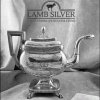






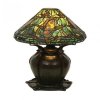








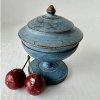










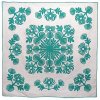









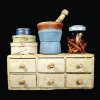





 Just when you think you've seen everything, you round a corner, and there's a pair of worn-out denim coveralls that came from a farm in Indiana, according to Stella Rubin of Darnestown, Maryland, who offered them at $675. They are so ragged, tattered, and crisscrossed with stitches that they ceased being clothing and became an art object.
Just when you think you've seen everything, you round a corner, and there's a pair of worn-out denim coveralls that came from a farm in Indiana, according to Stella Rubin of Darnestown, Maryland, who offered them at $675. They are so ragged, tattered, and crisscrossed with stitches that they ceased being clothing and became an art object.

 Gemini Antiques, Oldwick, New Jersey, brought some of its desirable toys to the show. The circa 1885 Cuzner Trotter, an Ives and Blakeslee & Co. toy, was tagged $5200 (Cuzner refers to the inventor of the mechanism that moves the horse's legs realistically). The circa 1875 Stevens & Brown Co. clockwork tricycle cost $3500.
Gemini Antiques, Oldwick, New Jersey, brought some of its desirable toys to the show. The circa 1885 Cuzner Trotter, an Ives and Blakeslee & Co. toy, was tagged $5200 (Cuzner refers to the inventor of the mechanism that moves the horse's legs realistically). The circa 1875 Stevens & Brown Co. clockwork tricycle cost $3500. This 20" x 25" (sight size) oil on canvas in a gilt frame, The Great Gale at Providence, Rhode Island, September 23, 1815, portrays an actual occurrence. The painting is after a print made by an artist who witnessed the event, James Kidder of Boston. The scene is Market Square in Providence, and many of the buildings and vessels involved are identified. A hurricane blew ashore, and Long Island and coastal Connecticut, Rhode Island, and Massachusetts were unprepared for the tides that ran up to 14 feet higher than usual. Don Olson of Rochester, New York, offered it for $42,000.
This 20" x 25" (sight size) oil on canvas in a gilt frame, The Great Gale at Providence, Rhode Island, September 23, 1815, portrays an actual occurrence. The painting is after a print made by an artist who witnessed the event, James Kidder of Boston. The scene is Market Square in Providence, and many of the buildings and vessels involved are identified. A hurricane blew ashore, and Long Island and coastal Connecticut, Rhode Island, and Massachusetts were unprepared for the tides that ran up to 14 feet higher than usual. Don Olson of Rochester, New York, offered it for $42,000. Don Olson asked $16,900 for the 42" long sheet copper salmon with brass fins and gill openings. It's not a weathervane but a New England-made trade sign of the mid-19th century. Its superb surface is a combination of paint layers and verdigris.
Don Olson asked $16,900 for the 42" long sheet copper salmon with brass fins and gill openings. It's not a weathervane but a New England-made trade sign of the mid-19th century. Its superb surface is a combination of paint layers and verdigris. Hilary and Paulette Nolan of Falmouth, Massachusetts, had some serious interest in the 1700-10 Massachusetts tavern table with a 36¾" x 23½" breadboard top and sausage-turned base when we stopped at their booth later. The table came from "a pioneer collection," said Hilary Nolan, who priced it at $23,000.
Hilary and Paulette Nolan of Falmouth, Massachusetts, had some serious interest in the 1700-10 Massachusetts tavern table with a 36¾" x 23½" breadboard top and sausage-turned base when we stopped at their booth later. The table came from "a pioneer collection," said Hilary Nolan, who priced it at $23,000. Raccoon Creek Antiques, Oley, Pennsylvania, mounted this display of weathervanes. Most shown are of cutout sheet iron. The leaping stag vane was $4200; the 30" long grasshopper of wood sheathed in copper cost $3200; the rooster-topped vane of wrought iron with pierced maker's initials and 1753 date, attributed to Michael Schaeffer, an early Berks County, Pennsylvania, craftsman, was $324,000; the locomotive was $4800; and the car was $14,000.
Raccoon Creek Antiques, Oley, Pennsylvania, mounted this display of weathervanes. Most shown are of cutout sheet iron. The leaping stag vane was $4200; the 30" long grasshopper of wood sheathed in copper cost $3200; the rooster-topped vane of wrought iron with pierced maker's initials and 1753 date, attributed to Michael Schaeffer, an early Berks County, Pennsylvania, craftsman, was $324,000; the locomotive was $4800; and the car was $14,000. HL Chalfant, West Chester, Pennsylvania, asked $36,000 for the pair of 28" x 23" (sight size) oil on canvas portraits from New York or New England. The man and woman are sitting in red-painted chairs decorated with gold stripes and are portrayed with very pleasant faces and nicely detailed finery.
HL Chalfant, West Chester, Pennsylvania, asked $36,000 for the pair of 28" x 23" (sight size) oil on canvas portraits from New York or New England. The man and woman are sitting in red-painted chairs decorated with gold stripes and are portrayed with very pleasant faces and nicely detailed finery. The charming 19" x 25¾" (sight size) oil on canvas winter sleighing scene, circa 1850, is attributed to Fanny Palmer (1812-1876), who worked for printmakers Currier and Ives. John Sideli of Wiscasset, Maine, asked $28,500 for the classic work.
The charming 19" x 25¾" (sight size) oil on canvas winter sleighing scene, circa 1850, is attributed to Fanny Palmer (1812-1876), who worked for printmakers Currier and Ives. John Sideli of Wiscasset, Maine, asked $28,500 for the classic work. The 6' long pine bench from New Mexico has great patina and was $2250 from Mark and Marjorie Allen of Gilford, New Hampshire. Under it is a 16 3/8" diameter Massachusetts wooden staved box in blue paint for $1650.
The 6' long pine bench from New Mexico has great patina and was $2250 from Mark and Marjorie Allen of Gilford, New Hampshire. Under it is a 16 3/8" diameter Massachusetts wooden staved box in blue paint for $1650.








